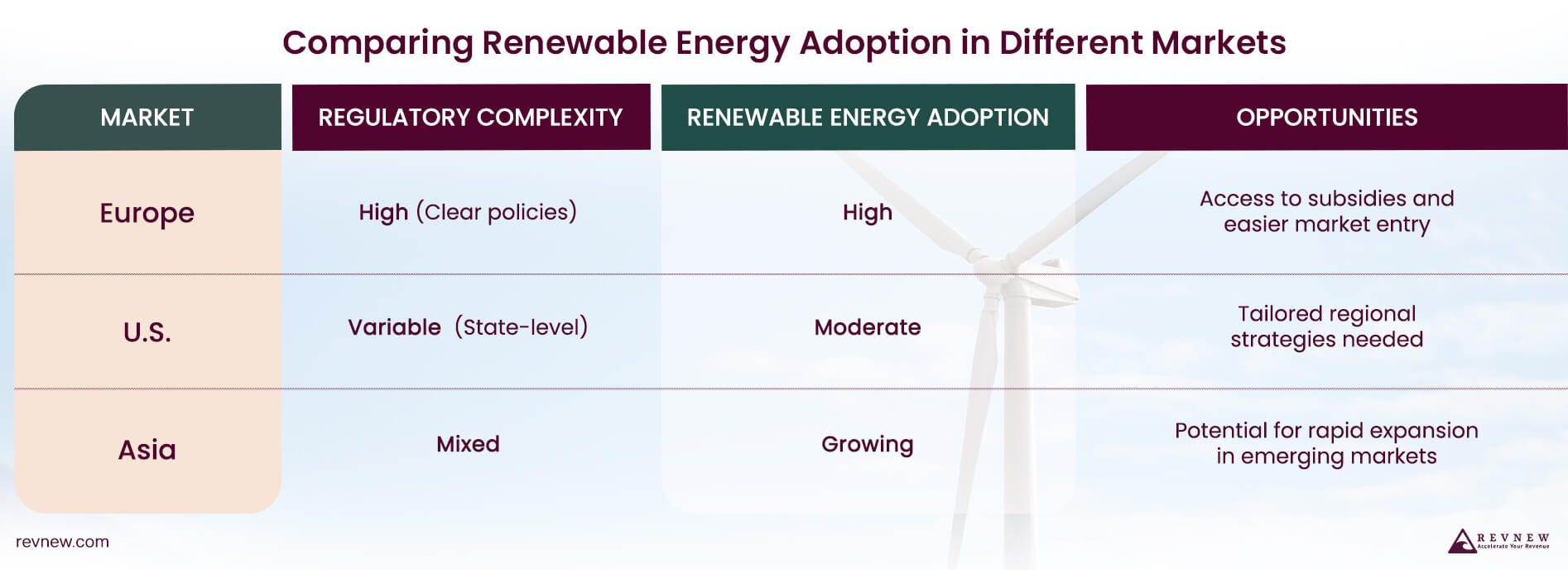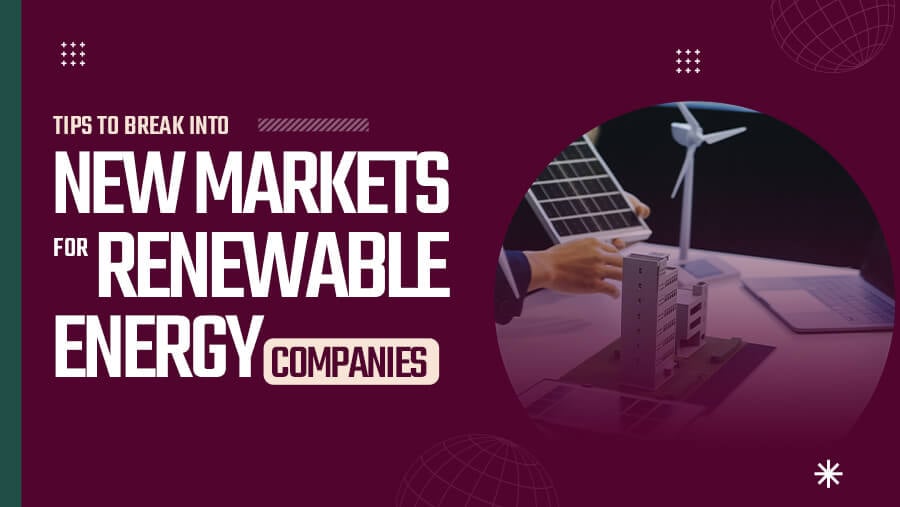
Tips to Break into New Markets for Renewable Energy Companies
With global energy demand projected to rise by 50% by 2050, the renewable energy sector is poised for explosive growth. But entering new markets is complex—navigating regulatory frameworks, customer skepticism, and fierce competition is no small feat.
How can you capture attention and secure high-value clients in this dynamic environment?
In this blog, we’ll reveal actionable, data-driven lead-generation strategies that renewable energy companies can use to fuel growth in untapped markets.
1. Conquer Market Entry Challenges with Smart Strategies
To successfully break into new markets, it’s essential to understand the landscape and proactively address key obstacles.
- Simplify Regulatory Compliance for Faster Market Entry
Each market has its own energy regulations and policies. Conduct thorough market research to ensure compliance and understand incentives that could benefit your clients.
- Adapt to Different Awareness Levels
Some regions may already be familiar with renewable energy, while others might still be skeptical. Customize your messaging to match the market’s readiness to adopt new energy solutions.
- Outpace the Competition
A crowded market makes it harder to stand out. Focus on what sets your solution apart—whether it’s efficiency, innovation, or cost savings.

2. Maximize High-Value Leads with Outbound Marketing
Outbound marketing plays a pivotal role in generating leads for renewable energy companies entering new markets. Rather than waiting for prospects to come to you, outbound marketing enables proactive outreach to targeted leads.
- Run Targeted Cold Email Campaigns
Personalization is critical. Instead of generic mass emails, craft data-driven, targeted messages that address specific pain points related to energy efficiency or sustainability.
- Boost Engagement with Cold Calls
Contrary to popular belief, cold calling still works. Educate prospects on how your renewable energy solutions can address their energy needs.
According to Statista (2023), 82% of B2B buyers are more likely to engage with sales representatives who reach out via cold calls.
3. Target the Right Decision-Makers with Data-Driven Approaches
Not all leads are created equal. To ensure your outbound marketing efforts pay off, you need to focus on the right decision-makers.
- Implement Account-Based Marketing (ABM)
ABM allows you to focus on key accounts and personalize outreach to decision-makers in companies that align with your product or service. Use platforms like LinkedIn Sales Navigator to identify target accounts.
- Use CRM and Lead Scoring
Tools like Salesforce or HubSpot can help prioritize leads based on their level of engagement. Lead scoring ensures your sales team focuses on high-quality prospects.
4. Craft a Compelling Value Proposition That Drives Action
Your value proposition needs to resonate with decision-makers by addressing their key pain points.
- Emphasize Sustainability
Many businesses are under pressure to lower their carbon footprints. Highlight how your renewable energy solutions can help them meet sustainability goals and align with environmental regulations.
- Showcase Long-Term Savings
Renewable energy solutions often come with high upfront costs, but the long-term financial benefits are substantial. Use data to demonstrate potential savings and return on investment (ROI).
McKinsey reports that businesses adopting sustainable technologies have reduced operational costs by up to 30% over five years (McKinsey, 2022).
5. Automate and Scale Lead Generation with Technology
Using technology allows renewable energy companies to scale their lead generation efforts more efficiently while maintaining a personalized touch.
- Automate Outreach with Marketing Tools
Platforms like HubSpot, Pardot, and Marketo allow you to automate email campaigns, lead nurturing, and follow-up communications, ensuring you don’t miss out on valuable leads.
- Leverage AI to Improve Outreach
Tools like Drift or Conversica use AI to personalize emails and automate follow-ups. AI can also analyze large datasets to identify the companies most likely to benefit from renewable energy solutions.
6. Build Trust and Authority with Educational Content
One of the best ways to nurture leads and build relationships is through thought leadership. Businesses are more likely to buy from companies that demonstrate expertise in the industry.
- Host Webinars and Virtual Events
Webinars are a great way to educate potential clients about new developments in renewable energy. Invite decision-makers to discussions on industry trends, technological innovations, and how policy changes might impact them.
- Create Case Studies and Whitepapers
Share in-depth case studies that show how your solutions have helped clients save money, reduce emissions, or improve efficiency.
Example: Siemens Energy consistently publishes detailed case studies and whitepapers, which has helped establish it as a trusted partner for renewable energy projects worldwide.
7. Form Strategic Partnerships to Expand Market Reach
Collaborating with complementary businesses or organizations can help your renewable energy company reach new prospects faster.
- Develop Channel Partnerships
Partnering with companies that offer complementary products or services—like energy storage or grid solutions—can help expand your market reach and add value to your offerings.
- Create a Referral Program
Incentivize existing clients or partners to refer new leads. Referrals often come with higher trust and are more likely to convert.
Example: A solar energy provider in the U.S. formed a strategic partnership with a leading sustainability consultancy, which resulted in a 20% increase in new business leads over six months.
8. Measure Your Success with Key Metrics
Tracking the effectiveness of your lead generation strategies is critical to ensure sustained growth and optimization of your efforts.
- Monitor Conversion Rates
Keep track of how many leads convert into sales opportunities. This will give insight into the effectiveness of your outreach and messaging.
- Track Cost Per Lead (CPL)
Measure the cost-effectiveness of each lead generation campaign. Lowering CPL can dramatically improve your marketing ROI.
- Evaluate Sales Qualified Leads (SQLs)
Focus on the number of SQLs—those leads who are ready to move forward with a purchasing decision. This will help align sales and marketing efforts.
According to HubSpot, companies with aligned sales and marketing teams see a 67% higher conversion rate from MQLs (Marketing Qualified Leads) to SQLs.
The Bottom Line
Breaking into new markets can be daunting, but with a strategic, data-driven approach, renewable energy companies can unlock significant growth opportunities. By leveraging outbound marketing, refining your value proposition, and embracing technology, you can not only generate high-quality leads but also build lasting relationships with clients. Focus on delivering value and measure your efforts continuously to drive long-term success.

.jpg?width=60&name=deepti%20(2).jpg)

